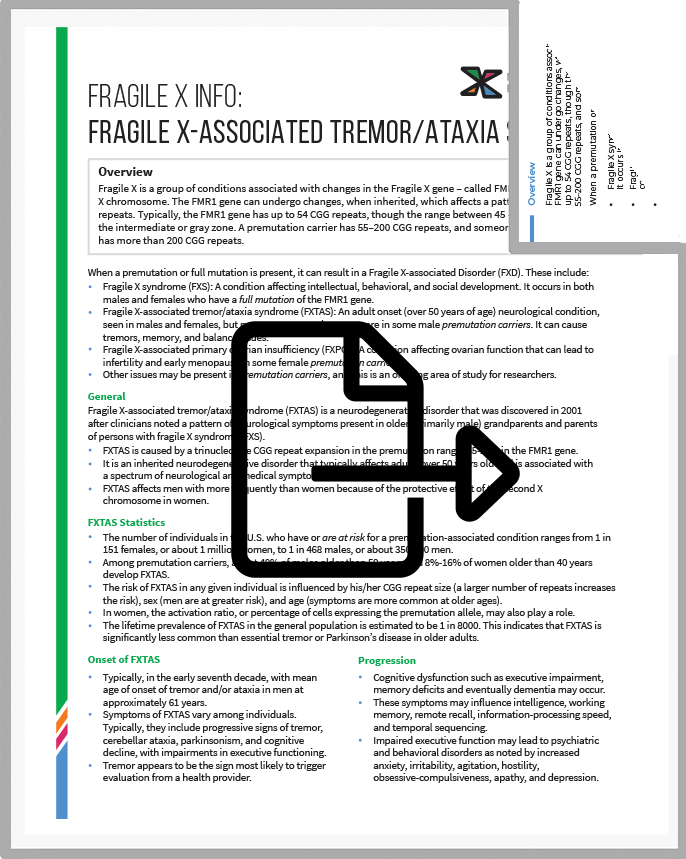Fragile X-Associated Tremor/Ataxia Syndrome | Info Series (original) (raw)
-
- Fragile X 101
* Fragile X 101
* Prevalence
* Signs and Symptoms
* Genetics and Inheritance
* Testing and Diagnosis - Fragile X Syndrome
* Fragile X Syndrome
* Newly Diagnosed
* Fragile X & Autism - Associated Conditions
* Premutation
* FXPOI
* FXTAS
* New Developments - Xtraordinary Individuals
- 31 Shareable Fragile X Facts
- Fragile X Info SeriesFact sheets by topic
- Fragile X MasterClass™️
- Knowledge CenterFrequently asked questions.
- Fragile X 101
-
- Resources for Families
- FXS Strategies by Topic
* Adulthood
* Autism
* Behavior
* COVID-19
* Daily Living
* Females
* Medications
* Physical & Medical Concerns
* Puberty & Sexuality
* School & Education - FXS Resources by Age
- Premutation Topics
* The Fragile X Premutation
* FXTAS Resources
* FXPOI Resources
* Reproductive Resources - Newly Diagnosed
- ResearchLearn and participate
* Research 101What is research?
* STX209 Reconsent ProjectEnrollment is open
* International Fragile X Premutation Registry — For ParticipantsEnroll now
* Participate in ResearchMyFXResearch Portal
* Original Research Articles
* FORWARD-MARCHDatabase and registry
* Research ResultsNew and archives - Find a Fragile X Clinic
* U.S. Fragile X Syndrome Clinics
* FXTAS-Specific Clinics
* International Clinics & Organizations - Find a Contact Near You
- Knowledge CenterOur Fragile X library
- Webinars & Videos
- Printable Resources
- Treatment Recommendations
-
- Resources for Professionals
- NFXF MasterClass™️ for Professionals
- Research Readiness ProgramResearch facilitation for researchers
- NFXF Data Repository
- International Fragile X Premutation Registry — Research Requests
- FORWARD-MARCHRegistry & Database
- NFXF-Led PFDD Meeting for Fragile X SyndromePatient-focused drug development
- Marketing Your Research Opportunities
- Treatment Recommendations
- Fragile X Clinics
* U.S. FXS Clinics
* FXTAS-Specific Clinics
* International Clinics & Organizations - NFXF RESEARCH AWARDS
* Randi J. Hagerman Summer Scholar Research Awards
* Junior Investigator Awards
Get
Involved-
- Fragile X 101
* Fragile X 101
* Prevalence
* Signs & Symptoms
* Genetics and Inheritance
* Testing and Diagnosis - Fragile X Syndrome
* Fragile X Syndrome
* Fragile X & Autism - Associated Conditions
* Premutation
* FXPOI
* FXTAS
* New Developments - Xtraordinary Individuals
- 31 Shareable Fragile X Facts
- Fragile X Info Series
- FRAGILE X MASTERCLASS
- Knowledge Center
- Fragile X 101
-
- Resources for Families
- FXS Strategies by Topic
* Adulthood
* Autism
* Behavior
* Daily Living
* Females
* Medications
* Physical & Medical Concerns
* Fragile X and Puberty & Sexuality
* School & Education - FXS Resources by Age
- Premutation Topics
* The Fragile X Premutation
* FXTAS Resources
* FXPOI Resources
* Reproductive Resources - Newly Diagnosed
- Research
* Research 101: What is Research?
* STX209 Reconsent Project
* International Fragile X Premutation Registry — For Participants
* Participate in Research
* Original Research Articles
* FORWARD-MARCH
* Research Results Roundup - Find a Clinic Near You
- Find a Contact Near Your
- Knowledge Center
- Webinars & Videos
- Printable Resources
- Treatment Recommendations
-
- Resources for Professionals
- NFXF MasterClass™️ for Professionals
- Research Readiness Program
- NFXF Data Repository
- International Fragile X Premutation Registry — Research Requests
- FORWARD-MARCH Registry & Database
- NFXF-Led Patient-Focused Drug Development Meeting
- Marketing Your Research Opportunities
- Treatment Recommendations
- Find a Clinic Near You
- NFXF Research Awards
* Randi J. Hagerman Summer Scholars
* Junior Investigator Awards
Fragile X Info Series: Fragile X-Associated Tremor/Ataxia Syndrome
Fragile X Info Series: Fragile X-Associated Tremor/Ataxia SyndromeDany Petraska2023-06-15T13:30:03-04:00
Fragile X Info Series
Fragile X-Associated Tremor/Ataxia Syndrome
Statistics, onset, progression, diagnosis, and interventions and treatments for FXTAS, an adult-onset neurological condition, seen primarily in males.
overview of fragile x syndrome and associated disorders
Fragile X is a group of conditions associated with changes in the Fragile X gene — called “FMRl” and located on the X chromosome. The FMRl gene can undergo changes, when inherited, which affect a pattern of DNA called “CGG repeats.” Typically, the FMRl gene has up to 54 CGG repeats, though the range between 45 and 54 repeats, is called the “intermediate” or “gray zone.” A premutation carrier has 55–200 CGG repeats, and someone with a full mutation has more than 200 CGG repeats.
When a premutation or full mutation is present, it can result in a Fragile X-associated disorder (FXD). These include:
FXS is a condition affecting intellectual, behavioral, and social development. It occurs in both males and females who have a full mutation of the FMRl gene.
FRAGILE X-ASSOCIATED TREMOR/ATAXIA SYNDROME
FXTAS is an adult onset (over 50 years of age) neurological condition, seen in males and females, but more common and more severe in some male premutation carriers. It can cause tremors, memory, and balance issues.
FRAGILE X-ASSOCIATED PRIMARY OVARIAN INSUFFICIENCY
FXPOI is a condition affecting ovarian function that can lead to infertility and early menopause in some female premutation carriers.
OTHER PREMUTATION CONDITIONS
FXTAS is a neurodegenerative disorder that was discovered in 2001 after clinicians noted a pattern of neurological symptoms present in older (primarily male) grandparents and parents of persons with FXS.
FXTAS is caused by a trinucleotide CGG repeat expansion in the premutation range (55–200) in the FMRl gene.
FXTAS is an inherited neurodegenerative disorder that typically affects adults over 50 years old and is associated with
a spectrum of neurological and medical symptoms.
FXTAS affects men with more frequently than women because of the protective effect of the second X chromosome in women.

FXTAS Statistics
- The number of individuals in the U.S. who have or are at risk for a premutation-associated condition ranges from 1 in 151 females, or about 1 million women, to 1 in 468 males, or about 350,000 men.
- Among premutation carriers, about 40% of males older than 50 years and 8%–16% of women older than 40 years develop FXTAS.
- The risk of FXTAS in any given individual is influenced by their CGG repeat size (a larger number of repeats increases the risk), sex (men are at greater risk), and age (symptoms are more common at older ages).
- In women, the activation ratio, or percentage of cells expressing the premutation allele, may also play a role.
- The lifetime prevalence of FXTAS in the general population is estimated to be 1 in 8,000. This indicates that FXTAS is significantly less common than essential tremor or Parkinson’s disease in older adults.
Onset of FXTAS
- Typically, in the early seventh decade, with mean age of onset of tremor and/or ataxia in men at approximately 61 years.
- Symptoms of FXTAS vary among individuals. Typically, they include progressive signs of tremor, cerebellar ataxia, parkinsonism, and cognitive decline, with impairments in executive functioning.
- Tremor appears to be the sign most likely to trigger evaluation from a health provider.
Diagnosis of FXTAS
- FXTAS only occurs in individuals who have a Fragile X (FMRl) premutation. Therefore, it is essential that anyone being considered for this diagnosis is tested for and confirmed as a premutation carrier. (Also see Fragile X Info Series: Testing.)
- Neurological exam.
- Magnetic resonance imaging (MRI) findings consistent with FXTAS, such as specific white matter lesions in the brain or generalized brain atrophy.
Treatment and Interventions
The goal of therapy for FXTAS is to reduce symptoms and eventually to slow the progression of disease. Management of FXTAS is complex and involves appropriate follow-up by an adult neurologist.
- Treatments for FXTAS should be individualized as symptoms vary in every individual.
- Treatments should also be approached globally utilizing medications, psychological counseling, rehabilitative interventions such as speech, occupational and physical therapy, and gait training.
- Consideration should also be given to supportive services and counseling for the family.
- Genetic counseling for individuals with FXTAS and their family members is recommended.
Notes
- All daughters of men diagnosed with FXTAS (those confirmed to be premutation carriers) will also be premutation carriers.
- For women with FXTAS (again, those confirmed to be premutation carriers), each child will have a 50% chance of receiving the FMRl mutation, with the potential of their premutation expanding to a full mutation (>200 CGG repeats).
- About 20% of women with the FMRl premutation develop Fragile X-associated primary ovarian insufficiency (FXPOI).
- Women with FXPOI do not have an increased risk of FXTAS compared with women who carry premutations and have normal ovarian function.
Find an FXTAS Doctor
Call the NFXF at (800) 688-8765. We also have a list of FXTAS-specific clinics. These clinics are comprised of doctors (primarily neurologists and movement disorder specialists), therapists, researchers, and other specialists who treat FXTAS by utilizing the best available scientific knowledge about the known causes of FXTAS. Specialists may be able to lessen the severity or slow the progression of symptoms.
DOWNLOAD THIS PAGE AS A PDF
Fragile X-Associated Tremor/Ataxia Syndrome
General information, statistics, onset, progression, diagnosis, and interventions and treatments.
How We Can Help
The NFXF is dedicated to serving the entire Fragile X community to live their best lives by providing the knowledge, resources, and tools, until, and even after more effective treatments and a cure are achieved. Learn more with Fragile X 101.
If you have questions please reach out to us at treatment@fragilex.org or call (800) 688-8765.

